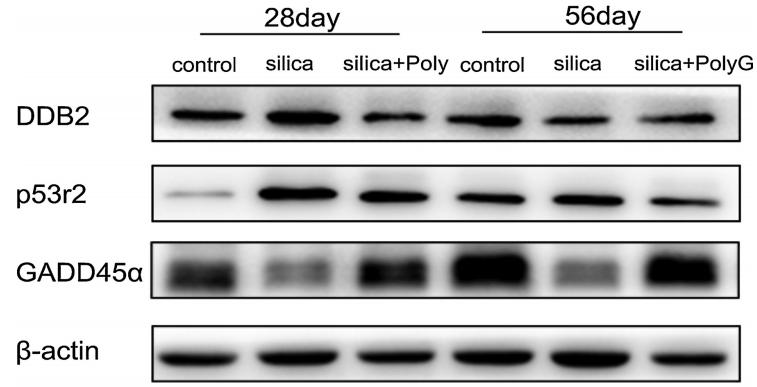| 产品: | DDB2 抗体 |
| 货号: | DF2439 |
| 描述: | Rabbit polyclonal antibody to DDB2 |
| 应用: | WB IF/ICC |
| 文献验证: | WB |
| 反应: | Human, Mouse |
| 预测: | Pig, Bovine, Horse, Sheep, Rabbit, Dog |
| 分子量: | 45 kDa; 48kD(Calculated). |
| 蛋白号: | Q92466 |
| RRID: | AB_2839645 |
产品描述
*The optimal dilutions should be determined by the end user.
*Tips:
WB: 适用于变性蛋白样本的免疫印迹检测. IHC: 适用于组织样本的石蜡(IHC-p)或冰冻(IHC-f)切片样本的免疫组化/荧光检测. IF/ICC: 适用于细胞样本的荧光检测. ELISA(peptide): 适用于抗原肽的ELISA检测.
引用格式: Affinity Biosciences Cat# DF2439, RRID:AB_2839645.
展开/折叠
damage-specific DNA binding protein 2; Damage-specific DNA-binding protein 2; DDB p48 subunit; Ddb2; DDB2_HUMAN; DDBb; DNA damage-binding protein 2; UV-damaged DNA-binding protein 2; UV-DDB 2; Xeroderma pigmentosum group E protei;
抗原和靶标
Ubiquitously expressed; with highest levels in corneal endothelium and lowest levels in brain. Isoform D1 is highly expressed in brain and heart. Isoform D2, isoform D3 and isoform D4 are weakly expressed.
- Q92466 DDB2_HUMAN:
- Protein BLAST With
- NCBI/
- ExPASy/
- Uniprot
MAPKKRPETQKTSEIVLRPRNKRSRSPLELEPEAKKLCAKGSGPSRRCDSDCLWVGLAGPQILPPCRSIVRTLHQHKLGRASWPSVQQGLQQSFLHTLDSYRILQKAAPFDRRATSLAWHPTHPSTVAVGSKGGDIMLWNFGIKDKPTFIKGIGAGGSITGLKFNPLNTNQFYASSMEGTTRLQDFKGNILRVFASSDTINIWFCSLDVSASSRMVVTGDNVGNVILLNMDGKELWNLRMHKKKVTHVALNPCCDWFLATASVDQTVKIWDLRQVRGKASFLYSLPHRHPVNAACFSPDGARLLTTDQKSEIRVYSASQWDCPLGLIPHPHRHFQHLTPIKAAWHPRYNLIVVGRYPDPNFKSCTPYELRTIDVFDGNSGKMMCQLYDPESSGISSLNEFNPMGDTLASAMGYHILIWSQEEARTRK
种属预测
score>80的预测可信度较高,可尝试用于WB检测。*预测模型主要基于免疫原序列比对,结果仅作参考,不作为质保凭据。
High(score>80) Medium(80>score>50) Low(score<50) No confidence
研究背景
Required for DNA repair. Binds to DDB1 to form the UV-damaged DNA-binding protein complex (the UV-DDB complex). The UV-DDB complex may recognize UV-induced DNA damage and recruit proteins of the nucleotide excision repair pathway (the NER pathway) to initiate DNA repair. The UV-DDB complex preferentially binds to cyclobutane pyrimidine dimers (CPD), 6-4 photoproducts (6-4 PP), apurinic sites and short mismatches. Also appears to function as the substrate recognition module for the DCX (DDB1-CUL4-X-box) E3 ubiquitin-protein ligase complex DDB1-CUL4-ROC1 (also known as CUL4-DDB-ROC1 and CUL4-DDB-RBX1). The DDB1-CUL4-ROC1 complex may ubiquitinate histone H2A, histone H3 and histone H4 at sites of UV-induced DNA damage. The ubiquitination of histones may facilitate their removal from the nucleosome and promote subsequent DNA repair. The DDB1-CUL4-ROC1 complex also ubiquitinates XPC, which may enhance DNA-binding by XPC and promote NER. Isoform D1 and isoform D2 inhibit UV-damaged DNA repair.
Phosphorylation by ABL1 negatively regulate UV-DDB activity.
Ubiquitinated by CUL4A in response to UV irradiation. Ubiquitination appears to both impair DNA-binding and promotes ubiquitin-dependent proteolysis. Degradation of DDB2 at sites of DNA damage may be a prerequisite for their recognition by XPC and subsequent repair. CUL4A-mediated degradation appears to be promoted by ABL1.
Ubiquitinated, leading to proteasomal degradation, and deubiquitinated by USP24.
Nucleus.
Note: Accumulates at sites of DNA damage following UV irradiation.
Ubiquitously expressed; with highest levels in corneal endothelium and lowest levels in brain. Isoform D1 is highly expressed in brain and heart. Isoform D2, isoform D3 and isoform D4 are weakly expressed.
Component of the UV-DDB complex which includes DDB1 and DDB2. The UV-DDB complex interacts with monoubiquitinated histone H2A and binds to XPC via the DDB2 subunit. Component of the DCX (DDB1-CUL4-X-box) E3 ubiquitin-protein ligase complex DDB1-CUL4-ROC1 (also known as CUL4-DDB-ROC1 and CUL4-DDB-RBX1), which includes CUL4A or CUL4B, DDB1, DDB2 and RBX1. DDB2 may function as the substrate recognition module within this complex. The DDB1-CUL4-ROC1 complex may associate with the COP9 signalosome, and this inhibits the E3 ubiquitin-protein ligase activity of the complex. A large number of other DCX complexes may also exist in which an alternate substrate targeting subunit replaces DDB2. These targeting subunits are generally known as DCAF (DDB1- and CUL4-associated factor) or CDW (CUL4-DDB1-associated WD40-repeat) proteins. Isoform D1 and isoform D2 do not interact with DDB1.
The DWD box is required for interaction with DDB1.
Interblade loops of the WD repeat region mediate most of the interaction with DNA. A hairpin between blades 5 and 6 inserts into DNA minor groove and mediates recognition of lesions and separation of the damaged and undamaged strands.
Belongs to the WD repeat DDB2/WDR76 family.
研究领域
· Cellular Processes > Cell growth and death > p53 signaling pathway. (View pathway)
· Genetic Information Processing > Replication and repair > Nucleotide excision repair.
· Genetic Information Processing > Folding, sorting and degradation > Ubiquitin mediated proteolysis. (View pathway)
· Human Diseases > Infectious diseases: Viral > Hepatitis B.
· Human Diseases > Cancers: Overview > Pathways in cancer. (View pathway)
· Human Diseases > Cancers: Overview > Transcriptional misregulation in cancer.
· Human Diseases > Cancers: Specific types > Colorectal cancer. (View pathway)
· Human Diseases > Cancers: Specific types > Pancreatic cancer. (View pathway)
· Human Diseases > Cancers: Specific types > Endometrial cancer. (View pathway)
· Human Diseases > Cancers: Specific types > Glioma. (View pathway)
· Human Diseases > Cancers: Specific types > Thyroid cancer. (View pathway)
· Human Diseases > Cancers: Specific types > Basal cell carcinoma. (View pathway)
· Human Diseases > Cancers: Specific types > Melanoma. (View pathway)
· Human Diseases > Cancers: Specific types > Chronic myeloid leukemia. (View pathway)
· Human Diseases > Cancers: Specific types > Small cell lung cancer. (View pathway)
· Human Diseases > Cancers: Specific types > Non-small cell lung cancer. (View pathway)
· Human Diseases > Cancers: Specific types > Breast cancer. (View pathway)
· Human Diseases > Cancers: Specific types > Hepatocellular carcinoma. (View pathway)
· Human Diseases > Cancers: Specific types > Gastric cancer. (View pathway)
文献引用
Application: WB Species: mouse Sample: lung
限制条款
产品的规格、报价、验证数据请以官网为准,官网链接:www.affbiotech.com | www.affbiotech.cn(简体中文)| www.affbiotech.jp(日本語)产品的数据信息为Affinity所有,未经授权不得收集Affinity官网数据或资料用于商业用途,对抄袭产品数据的行为我们将保留诉诸法律的权利。
产品相关数据会因产品批次、产品检测情况随时调整,如您已订购该产品,请以订购时随货说明书为准,否则请以官网内容为准,官网内容有改动时恕不另行通知。
Affinity保证所销售产品均经过严格质量检测。如您购买的商品在规定时间内出现问题需要售后时,请您在Affinity官方渠道提交售后申请。产品仅供科学研究使用。不用于诊断和治疗。
产品未经授权不得转售。
Affinity Biosciences将不会对在使用我们的产品时可能发生的专利侵权或其他侵权行为负责。Affinity Biosciences, Affinity Biosciences标志和所有其他商标所有权归Affinity Biosciences LTD.

